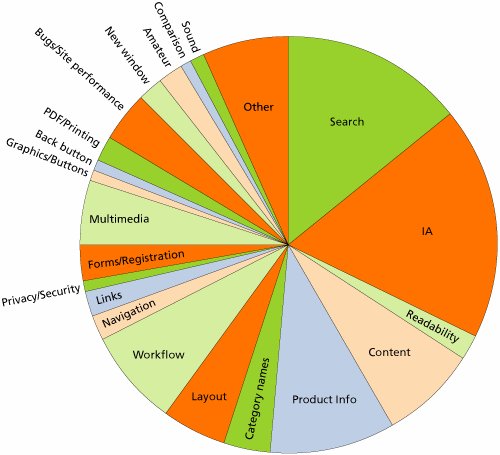Why Users Fail
| In the previous section, we discussed problems that primarily delay or annoy users but don't necessarily stop them from completing a task. Some problems are too severe to for average users to overcome, however. This chart shows problems that were severe enough to cause users to fail on a site either by leaving it, giving up on a task, or completing a task incorrectly. Usability problems weighted by how frequently they caused users to fail a task. These are the issues that stopped people in their tracks and prevented them from successfully accomplishing their tasks. Comparing all types of user problems to those that cause task failures, we can see some striking differences. Most notably, Search and information architecture are larger factors in task failures. This makes sense because nothing else really matters if you can't find what you're looking for.
Conversely, readability ranked third among the problems on our misery scale, but was much less significant to user failure. It's very annoying for readers to have to squint or lean forward because text is difficult to read, but they can usually suffer through it for a few minutes until they are finished with their task. Sometimes, of course, poor readability will cause people to leave or overlook an important piece of information, but usually it's more of an annoyance than a direct cause of failure.
As much as Web designers love to discuss the importance of elements such as graphics and layout, page design is not that important for people's ability to use Web sites. In the final pie chart, we grouped the design problems that cause task failure into yet broader categories. This can help you prioritize your design and make sure that you are focusing on the big areas that destroy the most business value if not corrected. Again, note that the two categories related to getting around Web sites Search and findability have assumed even more importance. Fifteen percent of task failures were caused by usability problems with Search, and a whopping 27 percent with findability problems. Difficult information or lack of information accounted for the second largest slice: 19 percent of task failures. Bigger categories of usability problems weighted by how frequently they caused users to fail a task. Notice the combined dominance of findability and information.  Again comparing user failure to general user misery, it's interesting to note that page design is more of an annoyance than a direct cause of failure. As much as Web designers love to discuss the importance of elements such as graphics and layout, page design is not that important for people's ability to use Web sites. Of course, you don't want any task failures on your site, so this is not an argument for ignoring page design. But it is an argument for giving higher priority to improving Search, findability, and the actual information that's presented on the pages. |
EAN: 2147483647
Pages: 107
